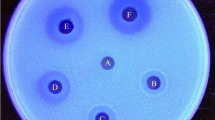Abstract
Microsomal and supernatant chitinase activities have been prepared from mycelial cultures ofMucor mucedo. Studies of their responses to changing temperature and phospholipid composition indicate that the lipid environment is important in regulating membrane-bound chitinase activity, but that supernatant chitinase activity does not have a phospholipid requirement. Membrane-bound chitinase was solubilized by different types of non-denaturing detergents. Maximum solubilization was achieved with 1 mM Zwittergent-14 or 1.2% Triton X-100 (93% and 90% solubilization, respectively). This solubilized chitinase activity could not be activated by protease treatment, i.e., was nonzymogenic, as was the supernatant chitinase. The insoluble residual chitinase activity was, however, zymogenic after treatment with 1.2% Triton X-100, but fully active after treatment with 3% Triton X-100.
Similar content being viewed by others
Literature Cited
Bradford, M. M. 1976. A rapid and sensitive method for the quantitation of microgram quantities of protein utilizing the principle of protein-dye binding. Analytical Biochemistry72:248–254.
Duran, A., Cabib, E. 1978. Solubilization and partial purification of yeast chitin synthase: confirmation of the zymogenic nature of the enzyme. Journal of Biological Chemistry253:4419–4425.
Gooday, G. W., Trinci, A. P. J. 1980. Wall structure and biosynthesis in fungi, pp. 207–251. In: Gooday, G. W., Lloyd, D., Trinci, A. P. J. (eds.), The eukaryotic microbial cell: 30th Symposium of the Society of General Microbiology. Cambridge: Cambridge University Press.
Humphreys, A. M., Gooday, G. W. 1984. Properties of chitinase activities fromMucor mucedo: evidence for a membrane-bound zymogenic form. Journal of General Microbiology130:1359–1366.
Montgomery, G. W. G. 1983. Studies on the purification of chitin synthase fromCoprinus cinereus. M.Sc. thesis, Aberdeen University, Aberdeen.
Navarrete, R., Serrano, R. 1983. Solubilization of yeast plasma membranes and mitochondria by different types of non-denaturing detergents. Biochimica et Biophysica Acta728:403–408.
Roelofsen, B., Van Deenen, L. L. M. 1973. Lipid requirement of membrane-bound ATPase: studies on human erythrocyte ghosts. European Journal of Biochemistry40:245–257.
Silvius, J. R., Read, B. D., McElhaney, R. N. 1978. Membrane enzymes: artifacts in Arrhenius plots due to temperature dependence of substrate-binding affinity. Science199:902–904.
Vermeulen, C. A., Wessels, G. H. 1983. Evidence for a phospholipid requirement of chitin synthase inSchizophyllum commune. Current Microbiology8:67–71.
Author information
Authors and Affiliations
Rights and permissions
About this article
Cite this article
Humphreys, A.M., Gooday, G.W. Phospholipid requirement of microsomal chitinase fromMucor mucedo . Current Microbiology 11, 187–190 (1984). https://doi.org/10.1007/BF01567348
Issue Date:
DOI: https://doi.org/10.1007/BF01567348




